Field Mappings Tab for OnePager Pro for Version 7.0
Contents
What Is Unlimited Field Mapping?
The Unlimited Field Mapping feature lets you use a source plan field that is not already available to you in the Chart Editor. The feature allows you to avoid going back to the Template Properties form to map additional fields for the specific purposes you need without having to recreate a new chart. Having to recreate a new chart is cumbersome and inefficient, especially if you already invested time editing the original chart before you realized that you needed another source plan field.
The Unlimited Field Mapping (UFM) feature is a vastly more efficient way to bring additional source plan fields into the Chart Editor after you've created and edited your chart. Previously, OnePager only had access to Microsoft Project source plan fields that were specifically mentioned in the OnePager Template Properties form. With UFM, the Chart Editor can access all source plan fields.
Field Mapping is defined as the use of a source plan field for a particular OnePager purpose. There are more than twenty-five (25) OnePager purposes from Baseline Finish Date to Unique task bar/milestone symbol identifier. You can easily refer back to your source plan and access changed fields from the Chart Editor.
For example, you can populate a Text field in Microsoft Project and then use that field to present data in an Text Column after the chart is first created. Further, OnePager Pro gives you a more efficient way to change the field mapping for eight (8) of the most frequently used OnePager Pro presentation purposes. For OnePager Express there are seven (7) such purposes because it omits display of critical path information.
For more information on Field Mapping, please see the Frequently Asked Questions topics at: [Field Mapping]
The Field Mapping Tab
The name of the new tab is the Field Mappings tab. Since the Unlimited Field Mapping feature allows you to access all fields from Microsoft Project source plans at any time in the life cycle of a chart, the Field Mappings tab no longer needs to map fields to extra purposes that are just carried along in case you need them.
The Field Mapping tab focuses on common OnePager purposes that users can map to Microsoft Project fields after a chart is created. Note, however, that other important OnePager purposes are on Rows/Swimlanes, Task Bars, and Milestones tabs. Some purposes such as Task Name, Percent-Complete, and Critical Path appear both on the Field Mapping tab and on the Task Bars and Milestones tabs. For OnePager Pro there are eight (8) purposes named in the Field Mappings tab: (1) Percent-complete, (2) Critical-path, (3) Task-name, (4) Start date, (5) Finish date, (6) Baseline start date, (7) Baseline finish date, (8) Deadline date.
The Field Mappings tab for the Chart Properties form is shown below:
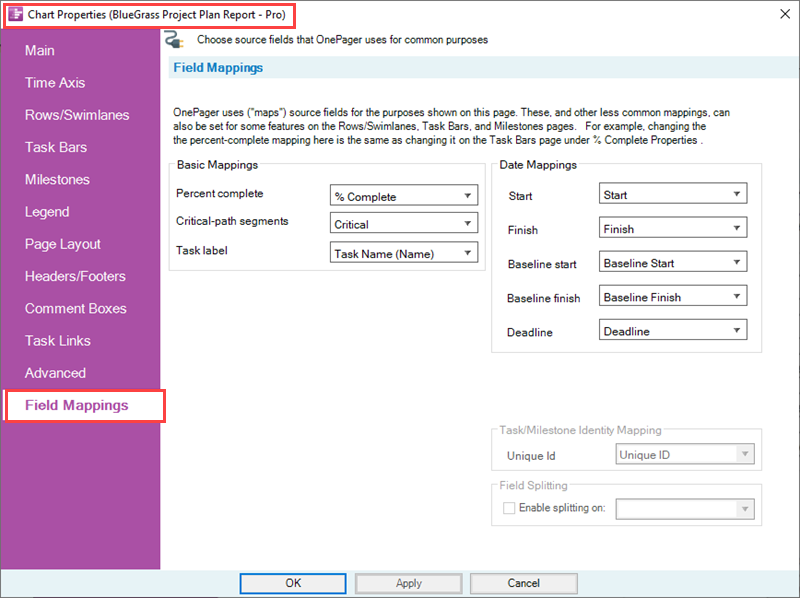
For more information on the Unlimited Column Mapping feature, please see the article at: Unlimited Field Mapping
Special Considerations for Enterprise Custom Fields (ECF)
For OnePager Pro, the Unlimited Field Mapping includes Enterprise Custom Fields (ECF). Care should be taken, however, that you have turned ON the ECF function in the current Template Properties form and established your connection to your project server service before creating the chart in the first place. The OnePager Pro Template Properties form's Field Mappings tab is shown below:
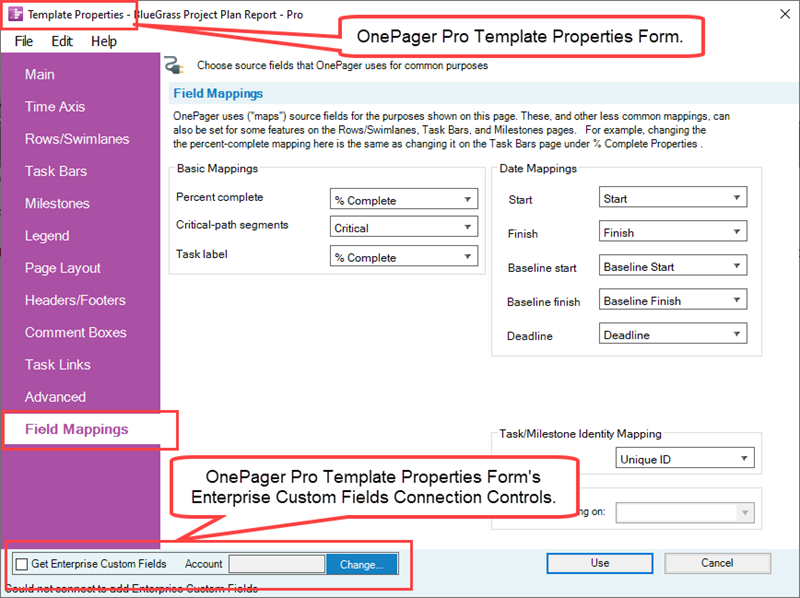
Special Considerations for the Task/Milestone Identity Mapping Feature
The Field Mappings tab shows the Microsoft Project field currently being used for the Task/Milestone Identity Mapping feature. In the Chart Properties form, the Task/Milestone Identity Mapping is disabled but tells you which Microsoft Project field is being used. The Task/Milestone Identity Mapping field being used is specified in the Template Properties form to act as an alternate Unique ID field for OnePager Pro UPDATE operations. You can change it to whatever field you want, but it is your responsibility to make sure that the chosen field has a unique value for each task you plan to import and display in OnePager. Having duplicate values in the Unique ID field causes task bars to be omitted and/or misidentified later on when you are doing updates of the chart.
Special Considerations for the Field Splitting Feature
OnePager Pro continues to support Field Splitting with the control on the Field Mappings tab in the Template Properties form and Chart Properties forms. Field Splitting can be performed on any source plan string type field with comma-separated components imported before the chart is created. It cannot be changed once a chart is created, though its value is shown in the Chart Properties form to remind you of the splitting that is active in the chart.
Field Mappings
There are four (4) controls groups found on the Field Mappings tab.
Basic Mappings
Within the Basic Mappings control group there are three (3) basic columns already established that can be remapped. You can use any Microsoft Project field of the appropriate type corresponding to the Basic Mapping field named for the dropdown.
The dropdown list for the Percent complete field is shown in the example below:
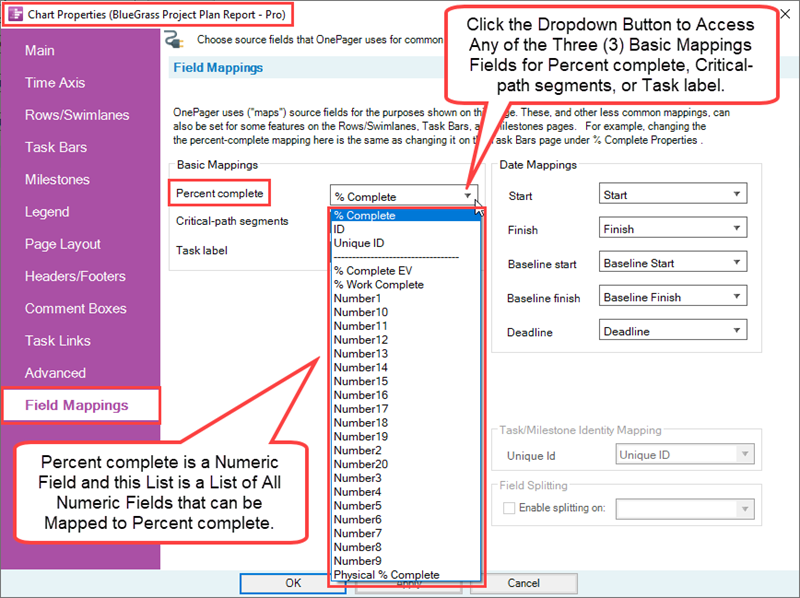
Selecting a different Microsoft Project field from the dropdown list tells OnePager to go back to the Microsoft Project source plan, retrieve the data for that field, and use that data for the purpose of the chart. This re-acquisition of Microsoft Project source plan data is done when you click Apply on the Chart Properties form which keeps the Chart Properties form visible or when you click OK which closes the Chart Properties form. The current chart is updated accordingly in the Chart Editor. The process for the other Basic Mapping fields for Critical-path segments and Task labels is the same as shown above for Percent complete.
Date Mappings
There are five (5) Date Mappings purposes in this control group that are available to be remapped. You can use any Microsoft Project date field that can be accessed in the individual dropdown lists as shown in the example below:
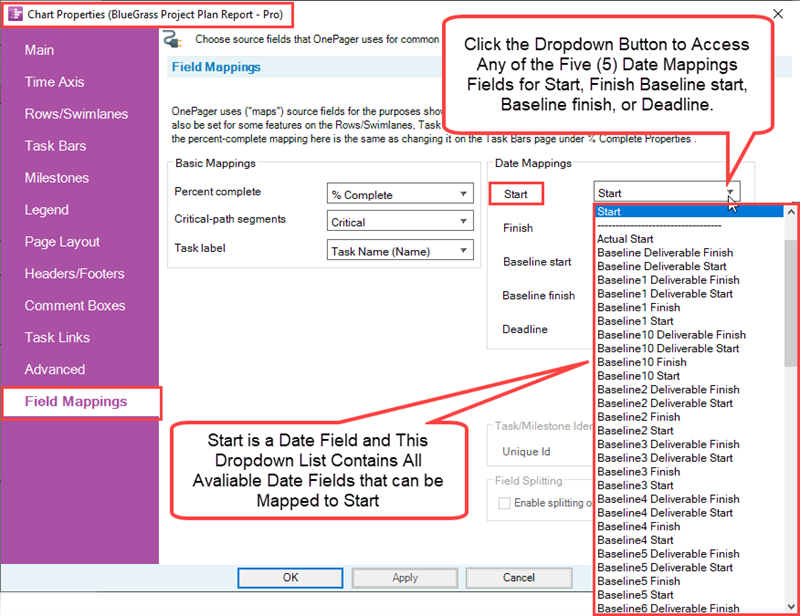
As with the selections in the Basic Mappings control group, selecting a different Microsoft Project field from the dropdown list tells OnePager to go back to the Microsoft Project source plan, retrieve the data for that field, and use that data for the designated the OnePager Pro purpose in the chart. This re-acquisition of Microsoft Project source plan data is done when you click Apply on the Chart Properties form which keeps the Chart Properties form visible or when you click OK which closes the Chart Properties form. The current chart is updated accordingly in the Chart Editor.
Task/Milestone Identity Mapping
Task/Milestone Identity Mapping for OnePager Pro Add-in and Desktop
In the Chart Properties form, this control group is informational. The control group is disabled in the Chart Properties form but the Unique Id window shows the setting previously or currently set in the Template Properties form’s Field Mappings tab. As such, the window is for information purposes only and cannot be changed.
The Task/Milestone Identity Mapping control group is shown below:
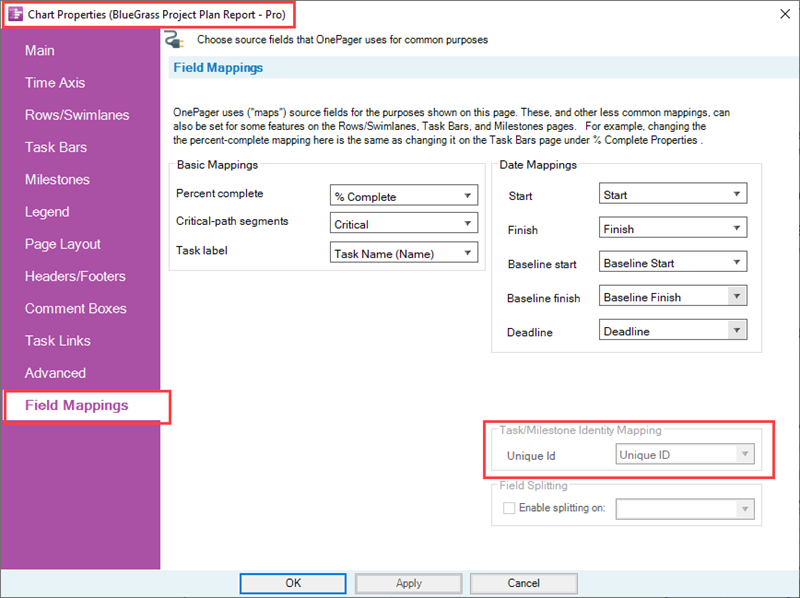
The Unique Id field shows the Microsoft Project field that OnePager Pro used when it first created the chart. This feature is provided to assist advanced OnePager Pro users update charts that were created from source plans where portions of one Microsoft Project source plan were copied into another. When OnePager updates a chart, it needs to identify each task and milestone that is being imported and find out if it already exists in chart. This is how OnePager preserves the formatting of the task bars/milestone symbols and places them in the same row/swimlane where they resided before the update.
When the data in the source plan are a .mpp file, OnePager has traditionally used the Microsoft Project Unique ID field for this purpose. However, you have no control over what values of Unique ID appear in the .mpp file when you copy data into that file. As a result, .mpp files that had data copied into them can have problems preserving OnePager Pro's formatting and row/swimlane positioning. To solve this problem, OnePager Pro lets you define and use a substitute Microsoft Project field as an alternative Unique ID for uniquely identifying tasks. You are then responsible for guaranteeing that these field values are preserved when data is copied from one .mpp file to another. You are also responsible for making sure that there are no duplicate values in the field designated for his alternative Unique ID usage.
The alternate Unique ID can be set in one of two places:
- 1) In the Template Properties form's Field Mappings tab and
- 2) In the OnePager Choices form's second page by clicking the Edit current template... button.
We strongly recommend that you set the alternate Unique ID in the Template Properties form rather than with the OnePager Choices form because this ensures that all charts use a consistent alternative Unique ID field.
For more information on Resetting Unique IDs on update, please see this section in the article at: Advanced Tab for OnePager Pro - Reset Unique Ids On Update
Task/Milestone Identity Mapping for OnePager Pro Using Source Plans from Microsoft Project Server and Microsoft Project Online
The discussion above focused on .mpp files as the Microsoft Project data source plans. The story is a little different if the source plan originates from a Microsoft Project Server or Microsoft Project Online source.
In these cases, there is no such thing as the Microsoft Project Unique ID field. In its place is a field that Microsoft calls the Global Unique ID or GUID field. The GUID field is what OnePager Pro has traditionally used to identify tasks/milestones that it imports directly from Microsoft Project Server/Online. Because typically Microsoft Project Server/Online users don't copy portions of server-based projects from one into another, the ability to define and use an alternative unique identifier is not as compelling as it is for .mpp files. But, you can still use the feature if you need special control over how task bars/milestone symbols are identified from these server sources.
For additional help, please see the OnePager Frequently Asked Questions page at: Selecting a Custom Unique ID
If you encounter difficulties, contact our Support Team at support ticket, by e-mailing us, or by calling +1.303.779.0344
Field Splitting
As with the control group discussed previously, the Field Splitting control group is disabled but shows the Microsoft Project field currently set in the Template Properties form as the field participating in field splitting. As such, the window is for information purposes only and cannot be changed.
The Field Splitting control group is shown below:
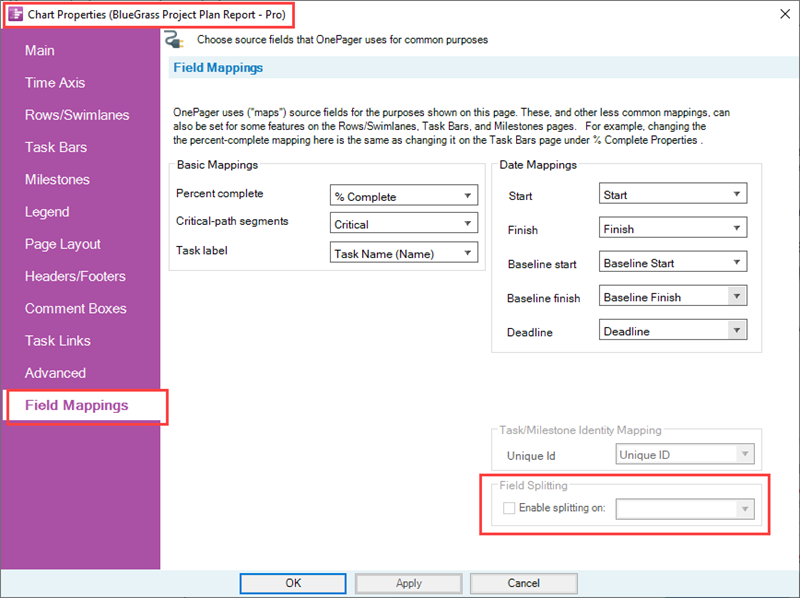
The Field Splitting control group in the Field Mappings tab of the OnePager Pro Chart Properties form works in the same way as it did in the Other Columns tab of previous versions.
For more information on Splitting and parsing columns, please see the article at: Splitting and Parsing Columns-OnePager Pro
Related Links
Advanced Tab for OnePager Pro-Reset Unique Ids On Update
Splitting and Parsing Columns-OnePager Pro
(21.15.1-70)